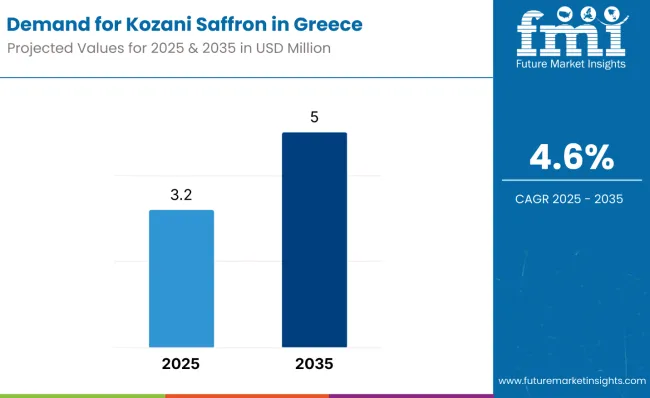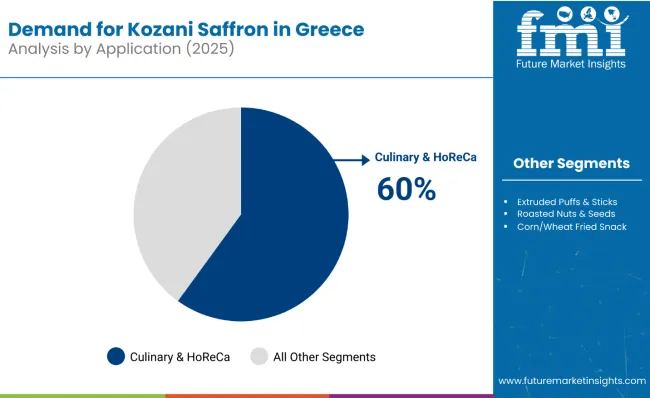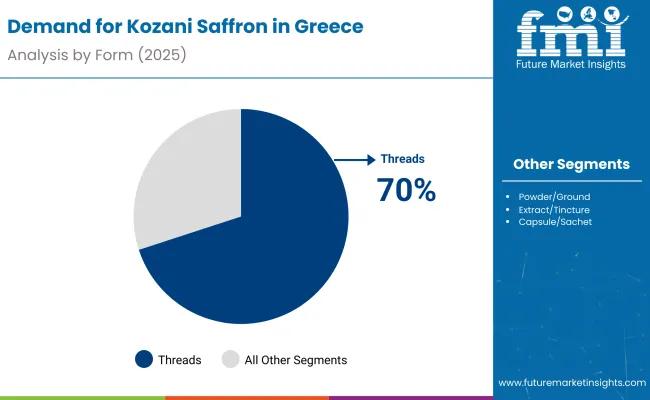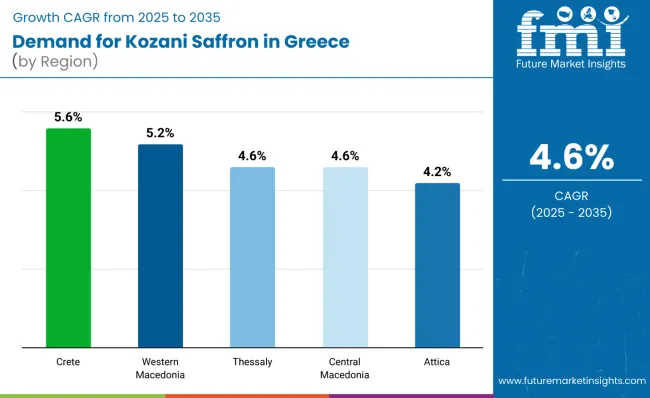Demand for Kozani saffron in Greece is estimated at USD 3.2 million in 2025, with projections indicating a rise to USD 5.0 million by 2035, reflecting a CAGR of approximately 4.65% over the forecast period. This growth reflects both a broadening consumer base and increased per capita consumption in key Greek regions.


The rise in demand is linked to growing culinary sophistication, increased appreciation for PDO products, and evolving premium spice usage trends. In 2025, per capita consumption in leading Greek regions such as Attica, Central Macedonia, and Crete varies significantly, with projections showing continued expansion through 2035. Attica leads among Greek regions, expected to generate USD 1.7 million in Kozani saffron sales by 2035, followed by Central Macedonia (USD 0.9 million), Crete (USD 0.5 million), Thessaly (USD 0.35 million), and Western Macedonia (USD 0.38 million).
The largest contribution to demand continues to come from culinary and HoReCa applications, which are expected to account for 62% of total sales by 2035, owing to strong gastronomic traditions, restaurant sector growth, and home cooking evolution. By distribution channel, online and direct sales represent the fastest-growing format, projected to reach 30% of all sales by 2035, while gourmet and specialty retail maintains strong positioning despite slight share decline.
Consumer adoption is particularly concentrated among culinary enthusiasts and quality-conscious households, with authenticity and origin certification emerging as significant drivers of demand. While price remains a premium consideration, the protected designation status of Kozani saffron maintains strong value perception.
Regional demand patterns show Attica maintaining leadership position through population density and purchasing power, while Crete demonstrates the strongest growth trajectory at 5.66% CAGR. Distribution strategies continue evolving, with digital channels and direct-from-producer sales gaining substantial traction alongside traditional specialty retail.
The Kozani saffron segment in Greece is classified across several categories. By application, the key segments include culinary and HoReCa uses covering both home cooking and restaurant applications, packaged foods and confectionery manufacturing, nutraceuticals and dietary supplements, cosmetics and personal care formulations, and gifts and specialty products.
By form, the segment spans traditional threads or stigmas, powder and ground preparations, extracts and tinctures, capsules and sachets, and other value-added products including infusions and blends. By distribution channel, the segment covers gourmet and specialty retail, hypermarkets and supermarkets, pharmacies and parapharmacies, online and direct sales, and duty-free and tourist channels. By geography, regions such as Attica, Central Macedonia, Crete, Thessaly, and Western Macedonia are key contributors, along with coverage across all Greek regions.

Culinary and HoReCa applications are projected to dominate demand by 2035, supported by Greece's strong gastronomic heritage, growing restaurant sophistication, and increased home cooking appreciation for premium ingredients. Other applications serve specialized consumer and commercial needs with varied growth trajectories.

Kozani saffron reaches consumers in various forms tailored to different applications and user preferences. Traditional threads maintain the largest share but face gradual decline as processed forms gain acceptance for convenience and specific applications.
Kozani saffron reaches consumers through diverse retail channels reflecting both traditional purchasing patterns and digital transformation trends. Online and direct sales demonstrate the strongest growth trajectory, while traditional channels maintain significant but declining shares.
Regional demand for Kozani saffron varies across Greek regions, reflecting local culinary traditions, income levels, tourism presence, and distribution accessibility. Attica maintains absolute leadership through population density and economic concentration, while Crete demonstrates the highest growth rate.

| Region | CAGR (2025 to 2035) |
|---|---|
| Crete | 5.66% |
| Western Macedonia | 5.24% |
| Thessaly | 4.65% |
| Central Macedonia | 4.65% |
| Attica | 4.27% |
Regional growth patterns for Kozani saffron reflect varying adoption rates, economic development, and culinary evolution across Greek regions. Crete leads in growth rate despite smaller absolute volumes, while Attica maintains dominance through consistent expansion from the largest base.
Between 2025 and 2035, demand for Kozani saffron is projected to expand across all major Greek regions, but growth rates vary based on tourism development, culinary sophistication, income growth, and retail expansion. Crete leads with the highest CAGR of 5.66%, driven by robust tourism growth, expanding luxury restaurant sector, growing local culinary pride, and increasing consumer sophistication among both residents and hospitality businesses seeking authentic Greek ingredients.
Western Macedonia follows with 5.24% CAGR, benefiting from direct proximity to saffron production areas, local awareness and pride in the PDO designation, developing culinary tourism initiatives, and growing direct-to-consumer sales opportunities that connect local producers with regional buyers.
Thessaly and Central Macedonia both maintain 4.65% growth, matching the national average. Thessaly benefits from agricultural region characteristics, growing appreciation for premium local products, and expanding connections to broader Greek culinary renaissance. Central Macedonia leverages Thessaloniki's position as northern Greece's culinary capital, established restaurant culture, and strong regional distribution networks.
Attica, while demonstrating moderate 4.27% growth, maintains its position as the dominant regional consumer due to Athens metropolitan concentration, highest absolute purchasing power, most developed gourmet retail infrastructure, and largest restaurant sector requiring premium ingredients.

The competitive environment features traditional family-owned Kozani producers alongside established Greek specialty food distributors. Authentic PDO certification and direct producer relationships remain decisive success factors, with leading suppliers maintaining traditional cultivation methods while expanding modern distribution capabilities.
Traditional Kozani saffron cooperatives maintain the most authentic positioning in the segment. Multi-generational farming families and local cooperatives offer directly-sourced saffron threads, powders, and value-added products, emphasizing PDO certification, hand-harvesting methods, and traditional processing techniques. These producers increasingly serve both professional culinary clients and quality-conscious consumers through direct sales and specialty retail partnerships.
Established Greek gourmet distributors leverage regional networks to place Kozanisaffron across specialty stores, high-end supermarkets, and professional culinary channels. These distributors often maintain exclusive relationships with select Kozani producers while providing consistent supply, proper storage, and marketing support to retail partners.
Artisan food producers across Greece have developed direct sourcing relationships with Kozani cultivators, incorporating authentic saffron into premium confectionery, traditional sweets, and specialty food products. These producers emphasize the Kozani provenance in their marketing while serving both domestic and export channels.
Regional specialty retailers, particularly in Athens and Thessaloniki, maintain curated selections of premium Kozani saffron products, emphasizing quality, authenticity, and proper usage education. These retailers often serve as bridges between traditional producers and urban consumers seeking authentic ingredients.
Online platforms specializing in Greek products have created direct connections between Kozani producers and consumers nationwide, enabling authentic sourcing stories, quality verification, and educational content about proper saffron usage and storage.
Key Developments
| Attribute | Details |
|---|---|
| Study Coverage | Greek demand and consumption of Kozani saffron from 2025 to 2035 |
| Base Year | 2025 |
| Forecast Period | 2025 to 2035 |
| Units of Measurement | USD (sales), regional share percentages, application percentages |
| Geography Covered | All Greek regions with focus on Attica, Central Macedonia, Crete, Thessaly, Western Macedonia |
| By Application | Culinary & HoReCa, Packaged foods & confectionery, Nutraceuticals & supplements, Cosmetics & personal care, Gifts & specialty |
| By Form | Threads (stigmas), Powder/ground, Extracts/tinctures, Capsules/sachets, Other value-added products |
| By Distribution Channel | Gourmet/Specialty retail, Hypermarkets/Supermarkets, Pharmacies/ Parapharmacies, Online/direct, Duty-free/Tourist & other |
| Metrics Provided | Sales (USD), Regional share, CAGR (2025 to 2035), Share by segment |
| Competitive Landscape | Producer profiles, distribution strategies, regional presence |
| Forecast Drivers | Regional demand trends, application expansion, PDO positioning, distribution evolution |
By 2035, total Greek demand for Kozani saffron is projected to reach USD 5.0 million, up from USD 3.2 million in 2025, reflecting a CAGR of approximately 4.65%.
Culinary & HoReCa applications hold the leading share, accounting for approximately 62% of total sales by 2035, followed by packaged foods & confectionery and nutraceuticals & supplements.
Crete leads in projected growth, registering a CAGR of 5.66% between 2025 and 2035, due to tourism growth, restaurant sector expansion, and increasing local culinary sophistication.
Online and direct sales are the fastest-growing channel, projected to reach 30% share by 2035, while gourmet and specialty retail maintains strong positioning with 28% share.
Traditional threads maintain leadership with 62% share by 2035, though powder and ground formats are growing rapidly to 18% share, driven by convenience factors and commercial applications.






Our Research Products

The "Full Research Suite" delivers actionable market intel, deep dives on markets or technologies, so clients act faster, cut risk, and unlock growth.

The Leaderboard benchmarks and ranks top vendors, classifying them as Established Leaders, Leading Challengers, or Disruptors & Challengers.

Locates where complements amplify value and substitutes erode it, forecasting net impact by horizon

We deliver granular, decision-grade intel: market sizing, 5-year forecasts, pricing, adoption, usage, revenue, and operational KPIs—plus competitor tracking, regulation, and value chains—across 60 countries broadly.

Spot the shifts before they hit your P&L. We track inflection points, adoption curves, pricing moves, and ecosystem plays to show where demand is heading, why it is changing, and what to do next across high-growth markets and disruptive tech

Real-time reads of user behavior. We track shifting priorities, perceptions of today’s and next-gen services, and provider experience, then pace how fast tech moves from trial to adoption, blending buyer, consumer, and channel inputs with social signals (#WhySwitch, #UX).

Partner with our analyst team to build a custom report designed around your business priorities. From analysing market trends to assessing competitors or crafting bespoke datasets, we tailor insights to your needs.
Supplier Intelligence
Discovery & Profiling
Capacity & Footprint
Performance & Risk
Compliance & Governance
Commercial Readiness
Who Supplies Whom
Scorecards & Shortlists
Playbooks & Docs
Category Intelligence
Definition & Scope
Demand & Use Cases
Cost Drivers
Market Structure
Supply Chain Map
Trade & Policy
Operating Norms
Deliverables
Buyer Intelligence
Account Basics
Spend & Scope
Procurement Model
Vendor Requirements
Terms & Policies
Entry Strategy
Pain Points & Triggers
Outputs
Pricing Analysis
Benchmarks
Trends
Should-Cost
Indexation
Landed Cost
Commercial Terms
Deliverables
Brand Analysis
Positioning & Value Prop
Share & Presence
Customer Evidence
Go-to-Market
Digital & Reputation
Compliance & Trust
KPIs & Gaps
Outputs
Full Research Suite comprises of:
Market outlook & trends analysis
Interviews & case studies
Strategic recommendations
Vendor profiles & capabilities analysis
5-year forecasts
8 regions and 60+ country-level data splits
Market segment data splits
12 months of continuous data updates
DELIVERED AS:
PDF EXCEL ONLINE
Demand Signal Repository Solutions Market Size and Share Forecast Outlook 2025 to 2035
Demand Side Management Market Size and Share Forecast Outlook 2025 to 2035
Demand Response Market Analysis - Size, Share, and Forecast Outlook 2025 to 2035
Demand for Industrial Pepper in USA Size and Share Forecast Outlook 2025 to 2035
Demand for Industrial Evaporative Condensers in USA Size and Share Forecast Outlook 2025 to 2035
Demand for Industrial Control Network Modules in UK Size and Share Forecast Outlook 2025 to 2035
Demand for Industrial Chocolate in EU Size and Share Forecast Outlook 2025 to 2035
Demand for Industrial & Institutional Cleaning Products in EU Size and Share Forecast Outlook 2025 to 2035
Demand for Zinc-Tin Alloy Sputtering Target in UK Size and Share Forecast Outlook 2025 to 2035
Demand for Lingonberry Powder in USA Size and Share Forecast Outlook 2025 to 2035
Demand for Lingonberry Powder in UK Size and Share Forecast Outlook 2025 to 2035
Demand for Miniature Duplex Connectors in USA Size and Share Forecast Outlook 2025 to 2035
Demand for 4-Inch SiC Laser Annealing Equipment in UK Size and Share Forecast Outlook 2025 to 2035
Demand for 4-Inch SiC Laser Annealing Equipment in the USA Size and Share Forecast Outlook 2025 to 2035
Demand for Joint Compound in EU Size and Share Forecast Outlook 2025 to 2035
Demand for Marine-grade Polyurethane in UK Size and Share Forecast Outlook 2025 to 2035
Demand for Stainless Steel 330 Refractory Anchor in USA Size and Share Forecast Outlook 2025 to 2035
Demand for Stainless Steel 330 Refractory Anchor in UK Size and Share Forecast Outlook 2025 to 2035
Demand for AGV Intelligent Management Systems in USA Size and Share Forecast Outlook 2025 to 2035
Demand for AGV Intelligent Management Systems in UK Size and Share Forecast Outlook 2025 to 2035

Thank you!
You will receive an email from our Business Development Manager. Please be sure to check your SPAM/JUNK folder too.
Chat With
MaRIA